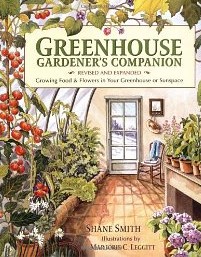 Working on assumption that growing plants in a greenhouse can be both good for the table and the spirit, Shane Smith present a vast amount of information about setting up and maintaining a greenhouse in an environmentally responsible way. As a resident of Cheyenne, Wyoming where he operates a “people oriented” solar greenhouse, he knows about the harsh conditions the environment can present and shows how everyone can have food, flowers, and fun from a home greenhouse.
Working on assumption that growing plants in a greenhouse can be both good for the table and the spirit, Shane Smith present a vast amount of information about setting up and maintaining a greenhouse in an environmentally responsible way. As a resident of Cheyenne, Wyoming where he operates a “people oriented” solar greenhouse, he knows about the harsh conditions the environment can present and shows how everyone can have food, flowers, and fun from a home greenhouse.
Smith divides the text into eleven chapters each one focusing on a different aspect of greenhouse gardening from planning and designing the greenhouse to plant selection and pest control. The book is not a “how-to” construction book but rather a manual with suggestions to guide you along the process of establishing and maintaining a productive greenhouse whether you start by buying a kit, renovating an old structure, or hiring someone to build the greenhouse. Before you make any move to start building reading this book will help you make the right decisions to ensure success.
Smith begins by discussing the way to optimize the greenhouse environment’s efficiency and productivity. He considers the basic factors important to interior and exterior greenhouse design such as glazing materials, lighting, carbon dioxide levels, composting, watering, temperature regulation, ventilation and space allocation. If you can not employ solar heat you might be especially interested in the section on thermal mass which explains the use of a material, usually water, to collect and store the sun’s energy for use when needed.
Smith explains that growing plants is not more difficult than growing them outdoors but it is different. Because the light, humidity, temperature, and atmosphere inside the greenhouse are different, gardening techniques, pest control, and timing are different too. Pollination without insects can be daunting but Smith explains ways to accomplish or get around it. Likewise, he gives plenty of good advice on plant propagation from sowing seeds to cloning and transplanting. A chapter on scheduling the production of flowers and fruits helps the grower increase the efficiency of the greenhouse by planting plants when they are most likely to respond well to the conditions produced by the greenhouse. The chapter on soil provides information on crop nutrition, fertilizers and their application, amendments, and mulching.
A substantial amount of space is devoted to discussing the growing of individual plants, organized by type; flowers, fruits and vegetables and herbs. For each entry specific instructions are given for such variables as lighting, fertilizing, watering, propagation, pest control, and scheduling. Smith’s advice helps you organize the crops so that plants with similar water and temperature needs are together while those with low light requirements are grown under those with high light requirements. The entry on coffee includes the suggestion that coffee plants grow best in pots and that if you want to trigger a mature plant into flowering and bean production you should mimic a dry season. Very important facts if you want to grow coffee successfully.
Seven appendices provide information on helpful associations and organizations, average percent of sunshine in cities across the nation, mail-order pest control suppliers, properties of greenhouse materials, mail-order plant suppliers, mail-order seed suppliers, and mail-order suppliers of green house supplies. The thoroughness of the book is reflected in the thoroughness of the appendices to provide readers with everything they need to know for successful greenhouse gardening. Even if your greenhouse is only in the “dream-stage”, this book will provide food for thought.
To buy Greenhouse Gardener’s Companion, Revised: Growing Food & Flowers in Your Greenhouse or Sunspace from Amazon.com click here.